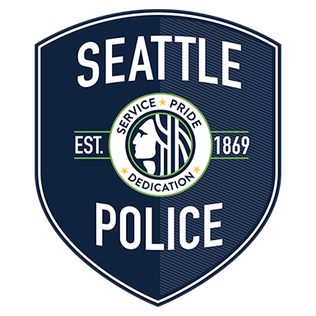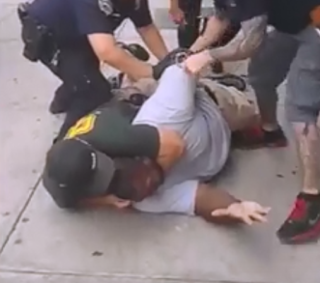Related Research Articles

The Omaha Race Riot occurred in Omaha, Nebraska, September 28–29, 1919. The race riot resulted in the lynching of Will Brown, a black civilian; the death of two white rioters; the injuries of many Omaha Police Department officers and civilians, including the attempted hanging of Mayor Edward Parsons Smith; and a public rampage by thousands of white rioters who set fire to the Douglas County Courthouse in downtown Omaha. It followed more than 20 race riots that occurred in major industrial cities and certain rural areas of the United States during the Red Summer of 1919.

The Seattle Police Department (SPD) is the principal law enforcement agency of the city of Seattle, Washington, United States, except for the campus of the University of Washington, which is under the responsibility of its own police department.

The 1981 Brixton riot, or Brixton uprising, was a series of clashes between mainly black youths and the Metropolitan Police in Brixton, London, between 10 and 12 April 1981. It resulted from racist discrimination against the black community by the mainly white police, especially the police's increased use of stop-and-search in the area, and ongoing tensions resulting from the deaths of 13 black teenagers and young adults in the suspicious New Cross house fire that January. The main riot on 11 April, dubbed "Bloody Saturday" by Time magazine, resulted in 279 injuries to police and 45 injuries to members of the public; over a hundred vehicles were burned, including 56 police vehicles; almost 150 buildings were damaged, thirty of which were burnt out, and many shops were looted. There were 82 arrests. Reports suggested that up to 5,000 people were involved. The Brixton riot was followed by similar riots in July in many other English cities and towns. The Thatcher government commissioned an inquiry, which resulted in the Scarman Report.

The 1992 Los Angeles riots were a series of riots and civil disturbances that occurred in Los Angeles County, California, United States, during April and May 1992. Unrest began in South Central Los Angeles on April 29, after a jury acquitted four officers of the Los Angeles Police Department (LAPD) charged with using excessive force in the arrest and beating of Rodney King. The incident had been videotaped by George Holliday, who was a bystander to the incident, and was heavily broadcast in various news and media outlets.

The Seattle Mardi Gras riot occurred on February 27, 2001, when disturbances broke out in the Pioneer Square neighborhood during Mardi Gras celebrations in Seattle, Washington. There were numerous random attacks on revelers over a period of about three and a half hours. There were reports of widespread brawling, vandalism, and weapons being brandished. Damage to local businesses exceeded $100,000. About 70 people were reported injured. Several women were sexually assaulted. One man, Kris Kime, died of injuries sustained during an attempt to assist a woman being brutalized.
The 1991 Washington, D.C., riot, sometimes referred to as the Mount Pleasant riot or Mount Pleasant Disturbance, occurred in May 1991, when rioting broke out in the Mount Pleasant neighborhood of Washington, D.C., in response to an African-American female police officer having shot a Salvadoran man in the chest following a Cinco de Mayo celebration.

The Broadwater Farm riot occurred on the Broadwater council estate in Tottenham, North London, on 6 October 1985.
The 1964 Rochester race riot was a riot that occurred in 1964 in Rochester, New York, United States. The riot occurred in the context of a rapidly-growing African American population in Rochester which had experienced discrimination in employment, housing, and policing in the preceding years. Violence began when the Rochester Police Department attempted to make an arrest at a block party on July 24, 1964. The riot lasted until July 26 and resulted in five deaths, four of which occurred in a helicopter crash in the city, as well as over 300 injuries and 900 arrests. In the aftermath of the riot, downtown Rochester received the attention of several new urban renewal and public housing projects, and local activists organized campaigns to change hiring practices in the city.

The Minneapolis Police Department (MPD) is the primary law enforcement agency in Minneapolis, Minnesota, United States. It is also the largest police department in Minnesota. Formed in 1867, it is the second-oldest police department in Minnesota, after the Saint Paul Police Department that formed in 1854. A short-lived Board of Police Commissioners existed from 1887 to 1890.

The King assassination riots, also known as the Holy Week Uprising, were a wave of civil disturbance which swept across the United States following the assassination of Martin Luther King Jr. on April 4, 1968. Some of the biggest riots took place in Washington, D.C., Baltimore, Chicago, and Kansas City.

On July 17, 2014, Eric Garner, a 43-year-old African American man, was killed in the New York City borough of Staten Island by Daniel Pantaleo, a New York City Police Department (NYPD) officer, after the latter put him in a prohibited chokehold while arresting him. Video footage of the incident generated widespread national attention and raised questions about the use of force by law enforcement.
The 1967 Milwaukee riot was one of 159 race riots that swept cities in the United States during the "Long Hot Summer of 1967". In Milwaukee, Wisconsin, African American residents, outraged by the slow pace in ending housing discrimination and police brutality, began to riot on the evening of July 30, 1967. The inciting incident was a fight between teenagers, which escalated into full-fledged rioting with the arrival of police. Within minutes, arson, looting, and sniping were occurring in the north side of the city, primarily the 3rd Street Corridor.
On August 13, 2016, a riot began in the Sherman Park neighborhood in Milwaukee, Wisconsin, sparked by the fatal police shooting of 23-year-old Sylville Smith. During the three-day turmoil, several people, including police officers, were injured and dozens of protesters arrested. A nightly curfew was set up for teenagers in the area.
"When the looting starts, the shooting starts" is a phrase originally used by Walter E. Headley, the police chief of Miami, Florida, in response to an outbreak of violent crime during the 1967 Christmas holiday season. He accused "young hoodlums, from 15 to 21", of taking "advantage of the civil rights campaign" that was then sweeping the United States. Having ordered his officers to combat the violence with shotguns, he told the press that "we don't mind being accused of police brutality". The quote may have been borrowed from a 1963 comment from Birmingham, Alabama police chief Bull Connor. It was featured in Headley's 1968 obituary published by the Miami Herald.

The George Floyd protests were a series of protests and civil disturbances that initially started in the Minneapolis–Saint Paul metropolitan area of Minnesota, United States, before spreading nationwide. In Columbus, Ohio, unrest began on May 28, 2020, two days after incidents began in Minneapolis. The events were a reaction to the murder of George Floyd by Minneapolis Police Department (MPD) officer Derek Chauvin, who knelt on Floyd's neck for over nine minutes, asphyxiating him.

Starting in May 2020, protests following the murder of George Floyd were held in the city of Portland, Oregon, concurrent with protests in other cities in the United States and around the world. By July 2020, many of the protests, which had been held every day since May 28, drew more than 1,000 participants. Protests continued into August, September, and October 2020, often drawing hundreds.
The 1967 Tampa riots were a series of race riots during June 1967 in Tampa, Florida, as one of 159 such riots in the United States that summer.

Law enforcement mounted a response to the January 6 United States Capitol attack, initially failing to maintain security perimeters and protect parts of the building from being breached and occupied, but succeeding at protecting members of Congress, and subsequently, as reinforcements arrived, to secure the breached Capitol.
The 1967 New York City riot was one of many riots that occurred during the long, hot summer of 1967. The riot began after an off-duty police officer, Patrolman Anthony Cinquemani, while trying to break up a fight, shot and killed a Puerto Rican man named Renaldo Rodriquez who had a knife and lunged toward him.
References
- ↑ Momodu, Samuel (December 25, 2020). "TAMPA BAY RACE RIOT (1967)". BlackPast. Archived from the original on 2021-01-26. Retrieved November 26, 2021.
- ↑ Upton, James; Rucker, Walter (2007). Encyclopedia of American Race Riots. Vol. 2. Greenwood Press. p. 629. ISBN 9780313333026 . Retrieved November 26, 2021.
- 1 2 3 Federal Emergency Management Agency & United States Fire Administration (1994). Report of the Joint Fire/Police Task Force on CIVIL UNREST Recommendations for Organization and Operations During Civil Disturbance (PDF). pp. 22–23. Archived from the original (PDF) on September 29, 2021. Retrieved November 26, 2021.
- ↑ Thompson, Morris (March 9, 1987). "AT TAMPA'S CORE, 'LIFE GETS WORSE'". The Washington Post. Retrieved November 26, 2021.
- 1 2 3 Calise, Gabrielle (June 3, 2020). "How 3 killings by police sparked past Tampa Bay riots". Tampa Bay Times . Retrieved November 26, 2021.
- 1 2 3 "Violence In Tampa After Death Of Another Black Man In Custody". Associated Press. April 7, 1987. Retrieved November 26, 2021.
- ↑ Leisner, Pat (February 20, 1987). "Uprising Follows Choke Hold Death of Tampa Man". AP News. Retrieved November 26, 2021.
- ↑ "Tampa's Mayor Credits Vote to Handling of Riot". Los Angeles Times. March 5, 1987. Retrieved December 9, 2021.
- ↑ "NAACP Sues City Over Fleeing Felon Shooting". AP News. April 10, 1987. Retrieved December 14, 2021.
- 1 2 3 "Tampa Policeman Quits One Day After Embattled Chief Resigns". AP News. May 6, 1986. Retrieved December 14, 2021.
- 1 2 3 4 "2 Tampa Officers Are Cleared". The New York Times. April 29, 1987. Retrieved November 30, 2021.
- ↑ "Death of Tampa Black Evokes New Violence". The New York Times. April 8, 1987. Retrieved November 30, 2021.
- ↑ Upton, James; Rucker, Walter (2007). Encyclopedia of American Race Riots. Vol. 2. Greenwood Press. pp. 629–630. Retrieved November 26, 2021– via Google Books.
- ↑ "Tampa Police Mourn Retired Chief Austin "AC" McLane". City of Tampa. January 16, 2021. Archived from the original on 2021-01-18. Retrieved December 14, 2021.
- 1 2 Fiallo, Josh (January 17, 2021). "Former Tampa police Chief Austin 'A.C.' McLane dies at age 81". Tampa Bay Times . Retrieved December 14, 2021.
- 1 2 "Austin Charles McLane". Thomas L. King Funeral Home and Cremation Service. Archived from the original on 2021-03-04. Retrieved December 14, 2021.
- ↑ Kite-Powell, Rodney (June 9, 2020). "We've been here before: A brief history of race relations in Tampa". 83 Degrees (Digital magazine). Issue Media Group. Retrieved November 26, 2021.
- ↑ Schweitzer, Sarah (September 30, 2005). "Leaving as she stayed: quietly". Tampa Bay Times. Retrieved November 26, 2021.
- 1 2 3 4 5 "Death of Tampa Suspect Called Cardiac Arrest". Los Angeles Times. February 3, 1989. Retrieved December 18, 2021.
- 1 2 "Tampa Violence Flares Again On Day After Suspect's Death". The New York Times (Digital). February 3, 1989. Retrieved March 25, 2022.
- 1 2 "DRUG ARREST TRIGGERS RIOT IN TAMPA". Deseret News. February 2, 1989. Retrieved December 18, 2021.
- 1 2 Federal Emergency Management Agency & United States Fire Administration (1994). Report of the Joint Fire/Police Task Force on CIVIL UNREST Recommendations for Organization and Operations During Civil Disturbance (PDF). p. 23. Archived from the original (PDF) on September 29, 2021. Retrieved December 18, 2021.